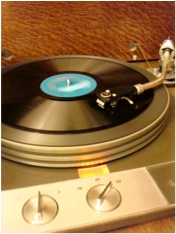As we celebrate yet another Commemoration Day at the Royal Albert Hall I thought the time was right to bring you the few recordings we have from earlier years. At the end, I’ll mention technical challenges involved with the transfer of the first two recordings onto modern formats.
Although you’ll find this first recording elsewhere I’ll include it again for completeness.
The October Commemoration Day graduation ceremonies recall the visit made to the College by King George 6th and Queen Elizabeth in 1945, on the centenary of the foundation of the Royal College of Chemistry, Imperial College’s oldest forerunner. King George said: “You students here assembled – men and women who soon will be going out from the Imperial College to your work in the world – have not only an opportunity but also a responsibility greater than men of science have known before. To you, I say: Regard your knowledge and your skill always in the light of a trust for the benefit of humanity, and thereby ensure, so far as in you lies, that science may never be put to uses which offend the higher conscience of mankind.”
For those unfamiliar with King George 6th, he battled throughout his life with a nervous stammer and his attempts to overcome this during the speech are obvious with long pauses between sentences.
From 1945 we jump to 1952 and a recording that, so far, I have no idea exactly why it was made. It features Karl Compton who was a prominent American physicist and president of the Massachusetts Institute of Technology (MIT) from 1930 to 1948. In 1948 he resigned his post as President of MIT and was elected president of the MIT Corporation. He held that position until his death on June 22, 1954, some two years after this sound recording was made. Compton was awarded a fellowship in 1949 but was unable to attend, but in 1952 he was special visitor and collected it then. Interesting references are made to key players in college life at that time: Chairman, Viscount Falmouth; Rector, Sir Roderic Hill along with Sir Henry Tizard, Sir Richard Southwell and Sir George Thomson. There is only part of the introduction by Viscount Falmouth to Karl Compton on the original tape, so it will sound a bit truncated. At the end, Compton reads greetings to the Imperial community from the President and also the Chairman of MIT and the American national anthem is played. Could this be why it was recorded?
Finally, we have something visual in the form of a 16mm colour film shot in 1973. Robert W Sarnoff was President of RCA (Radio Corporation of America). He was the eldest son of broadcasting mogul Brig. Gen. David Sarnoff, he followed in his father’s professional footsteps throughout his career at NBC and RCA. The citation for Sarnoff indicates that he was the benefactor of the Imperial College Haldane Music Library. A year later in 1974 Sarnoff married Metropolitan Opera diva Anna Moffo, so maybe opera was his interest as well as being the music library benefactor? As I understand it, Sarnoff himself paid for large parts of the 1973 Commemoration Day ceremony to be filmed in colour and with sound. Lord Flowers was Rector at the time and is seen in this current extract. This is the earliest moving picture record the college has of one of its ceremonies and it’s thanks to Robert Sarnoff that this happened. One of the greatest achievements by RCA and Sarnoff in particular was the development and introduction of colour TV in the USA. He was the first person to be officially televised in colour at the dedication ceremony of NBC’s new Washington, D.C. facilities on May 22, 1958. For those interested, you can see an amazing videotape that has been rediscovered of this 1958 event. The program represents the earliest known colour recording discovered to date.

The first two sound recordings could have been lost for ever had we not transferred them onto modern formats. The 1945 recording of King George 6th is held on 78rpm shellac discs which are very delicate and will break if dropped. I had these transferred by the National Sound Archive a few years ago. Although, in theory it’s easy to copy these discs, using the correct pick-up weight and stylus is essential. Using a modern LP stylus will simply “bottom’ into the disc’s groove and produce more scratch and crackle then actual sound and can damage it too.
The second recording IS interesting. I discovered that the recording tape used paper as the backing, rather than a form of plastic and its manufacture probably dates from the 1940’s. The oxide was also very basic and looked more like gunpowder than anything you could record sound on! Transferring the tape was also a challenge as I had to run the tape very slowly because it was sticking to itself like a reel of sticky parcel tape. A lot of background noise will he heard and I’m still amazed I managed to get anything off of it anyway.
I hope you have enjoyed listening to our recordings of Commemoration Days from the past….unless YOU have something we don’t know about?
Colin Grimshaw – October 2010